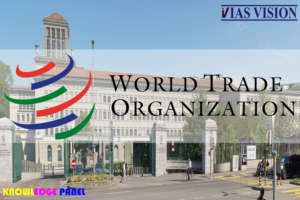WTO Director Members Agreeements
WTO STRUCTURE and WORKING
WTO FACTS & FIGURES
WTO FACTS for UPSC:
WTO is the world's largest international economic organization, with 166 member states representing over 98% of global trade.

- Latest entrants to WTO Comoros and Timor Leste became the 165th and 166th members on 26 February 2024, at the 13th Ministerial Conference in Abu Dhabi.
- Marrakesh Agreement led to creation - It officially commenced operations on 1 January 1995, pursuant to the 1994 Marrakesh Agreement, thus replacing the General Agreement on Tariffs and Trade (GATT) that had been established in 1948.
- Meets every two years - The highest decision-making body of the WTO, the Ministerial Conference, usually meets every two years. It brings together all members of the WTO, all of which are countries or customs unions.
- 4 year terms -Procedures for the appointment of the WTO director-general were updated in January 2003,and include 4 year terms.
- Current director-general is Ngozi Okonjo-Iweala, a Nigerian citizen.
- World Trade Report (WTR) is the annual report published since 2003 by the World Trade Organization.
Non-tariff barriers to trade
WTO FACTS for UPSC:
Non-tariff barriers to trade are trade barriers that restrict imports or exports of goods or services through mechanisms other than the simple imposition of tariffs. Such barriers are subject to controversy and debate, as they may comply with international rules on trade yet serve protectionist purposes., thereby thwarting WTO plans & progress.
industrialized countries have moved from tariffs to NTBs is the fact that developed countries have sources of income other than tariffs.
With the exception of export subsidies and quotas, NTBs are most similar to the tariffs.
Examples of Non-tariff barriers to trade :
- Administrative and bureaucratic delays at the border increase uncertainty and the cost of maintaining inventory.
- Embargoes are outright prohibition of trade in certain commodities.[10]As well as quotas, embargoes may be imposed on imports or exports of particular goods in respect of certain goods supplied to or from specific countries, or in respect of all goods shipped to certain countries.
- Foreign exchange restrictions and foreign exchange controlsoccupy an important place among the non-tariff regulatory instruments of foreign economic activity.
- administrative regulation of capital movements between states.
- Localization - importing country may require the prospective exporter to include a degree of local participation in the product or service.
- Standards take a special place among non-tariff barriers. Countries usually impose standards on classification, labelling and testing of products to ensure that domestic products meet domestic standards, but also to restrict sales of products of foreign manufacture unless they meet or exceed these same standards.
- Licensing of foreign trade is closely related to quantitative restrictions – quotas – on imports and exports of certain goods.
More about WTO
The WTO oversees about 60 different agreements which have the status of international legal texts. Member countries must sign and ratify all WTO agreements on accession. A discussion of some of the most important agreements follows.
The Agreement on Agriculture came into effect with the establishment of the WTO at the beginning of 1995. The AoA has three central concepts, or "pillars": domestic support, market access and export subsidies.
The General Agreement on Trade in Services was created to extend the multilateral trading system to service sector, in the same way as the General Agreement on Tariffs and Trade (GATT) provided such a system for merchandise trade. The agreement entered into force in January 1995.
The Agreement on Trade-Related Aspects of Intellectual Property Rights sets down minimum standards for many forms of intellectual property (IP) regulation. It was negotiated at the end of the Uruguay Round of the General Agreement on Tariffs and Trade (GATT) in 1994.
The Agreement on the Application of Sanitary and Phytosanitary Measures—also known as the SPS Agreement—was negotiated during the Uruguay Round of GATT, and entered into force with the establishment of the WTO at the beginning of 1995. Under the SPS agreement, the WTO sets constraints on members' policies relating to food safety (bacterial contaminants, pesticides, inspection, and labeling) as well as animal and plant health (imported pests and diseases).
The Agreement on Technical Barriers to Trade is an international treaty of the World Trade Organization. It was negotiated during the Uruguay Round of the General Agreement on Tariffs and Trade and entered into force with the establishment of the WTO at the end of 1994. The object ensures that technical negotiations and standards, as well as testing and certification procedures, do not create unnecessary obstacles to trade".
The Agreement on Customs Valuation, formally known as the Agreement on Implementation of Article VII of GATT, prescribes methods of customs valuation that Members are to follow. Chiefly, it adopts the "transaction value" approach.
In December 2013, the biggest agreement within the WTO was signed and known as the Bali Package.
